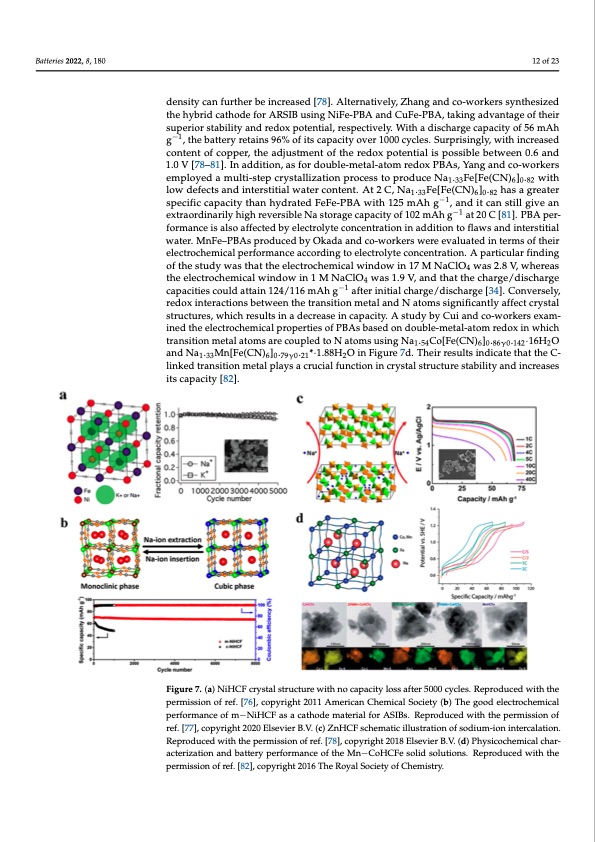
PDF Publication Title:
Text from PDF Page: 012
method of ZnFe-PBAs, the energy density can further be increased [78]. Alternatively, Zhang and co-workers synthesized the hybrid cathode for ARSIB using NiFe-PBA and CuFe-PBA, taking advantage of their superior stability and redox potential, respectively. Batteries 2022, 8, 180 With a discharge capacity of 56 mAh g−1, the battery retains 96% of its capacity over 1000 cycles. Surprisingly, with increased content of copper, the adjustment of the redox poten- tial is possible between 0.6 and 1.0 V [78–81]. In addition, as for double-metal-atom redox 12 of 23 density can further be increased [78]. Alternatively, Zhang and co-workers synthesized PBAs, Yang and co-wthoerkhyebrsridemcatphlodyeefdor aARmSIuBltuis-isntgepNicFrey-PsBtaAllainzdatCiounFep-PrBoAc,etsaskitnog apdrvoadnutacgee of their superior stability and redox potential, respectively. With a discharge capacity of 56 mAh Na1.33Fe[Fe(CN)6]0.82 with low defects and interstitial water content. At 2 C, g−1, the battery retains 96% of its capacity over 1000 cycles. Surprisingly, with increased Na1.33Fe[Fe(CN)6]0.82 has a greater specific capacity than hydrated FeFe-PBA with 125 mAh content of copper, the adjustment of the redox potential is possible between 0.6 and g−1, and it can still give an extraordinarily high reversible Na storage capacity of 102 mAh 1.0 V [78–81]. In addition, as for double-metal-atom redox PBAs, Yang and co-workers g−1 at 20 C [81]. PBA performance is also affected by electrolyte concentration in addition employed a multi-step crystallization process to produce Na1.33Fe[Fe(CN)6]0.82 with to flaws and interstitilaowl wdeaftecrt.s aMndnFinet–ePrsBtiAtiasl pwraotedruccoendtenbty. AOt k2 aCd, aNan. dFce[oF-ew(CoNrk) e]rs. wheasrea greater 1 33 6 0 82 specific capacity than hydrated FeFe-PBA with 125 mAh g−1, and it can still give an evaluated in terms of their electrochemical performance according to electrolyte concen- extraordinarily high reversible Na storage capacity of 102 mAh g−1 at 20 C [81]. PBA per- tration. A particular finding of the study was that the electrochemical window in 17 M formance is also affected by electrolyte concentration in addition to flaws and interstitial NaClO4 was 2.8 V, whereas the electrochemical window in 1 M NaClO4 was 1.9 V, and water. MnFe–PBAs produced by Okada and co-workers were evaluated in terms of their −1 that the charge/dischaerlgecetrcoacpheamcitciaelspcerofuorlmdaantcteaiancc1or2d4i/n1g1t6o meleActhroglyteacfotnecrenintriattiiaolnc. hAaprgaret/icduilsa-r finding of the study was that the electrochemical window in 17 M NaClO was 2.8 V, whereas charge [34]. Conversely, redox interactions between the transition metal and N4atoms sig- the electrochemical window in 1 M NaClO was 1.9 V, and that the charge/discharge nificantly affect crystal structures, which results in a decrease in capacity. A study by Cui capacities could attain 124/116 mAh g−1 after initial charge/discharge [34]. Conversely, and co-workers examined the electrochemical properties of PBAs based on double-metal- redox interactions between the transition metal and N atoms significantly affect crystal atom redox in which transition metal atoms are coupled to N atoms using structures, which results in a decrease in capacity. A study by Cui and co-workers exam- ined the electrochemical properties of PBAs based on double-metal-atom redox in which Na1.54Co[Fe(CN)6]0.86γ0.142·16H2O and Na1.33Mn[Fe(CN)6]0.79γ0.21*·1.88H2O in Figure 7d. transition metal atoms are coupled to N atoms using Na1.54Co[Fe(CN)6]0.86γ0.142·16H2O Their results indicate that the C-linked transition metal plays a crucial function in crystal and Na1.33Mn[Fe(CN)6]0.79γ0.21*·1.88H2O in Figure 7d. Their results indicate that the C- structure stability and increases its capacity [82]. linked transition metal plays a crucial function in crystal structure stability and increases its capacity [82]. 4 Figure 7. (a) NiHCF crystal structure with no capacity loss after 5000 cycles. Reproduced with the Figure 7. (a) NiHCF crystal structure with no capacity loss after 5000 cycles. Reproduced with the permission of ref. [76], copyright 2011 American Chemical Society (b) The good electrochemical permission of ref. [76], copyright 2011 American Chemical Society (b) The good electrochemical performance of m−NiHCF as a cathode material for ASIBs. Reproduced with the permission of performance of m−NiHCF as a cathode material for ASIBs. Reproduced with the permission of ref. ref. [77], copyright 2020 Elsevier B.V. (c) ZnHCF schematic illustration of sodium-ion intercalation. [77], copyright 2020 ElseRveiperoBd.uVce.d(cw)iZthntHheCpFersmcihsseimonaotficreifl.lu[7s8t]r,acotipoynrigohfts2o0d18iuEmlse-vioienr Bin.Vt.e(rdc)aPlahtyisoicno.cRhem-ical char- acterization and battery performance of the Mn−CoHCFe solid solutions. Reproduced with the produced with the permission of ref. [78], copyright 2018 Elsevier B.V. (d) Physicochemical charac- permission of ref. [82], copyright 2016 The Royal Society of Chemistry. terization and battery performance of the Mn−CoHCFe solid solutions. Reproduced with the per- mission of ref. [82], copyright 2016 The Royal Society of Chemistry. 3.2. Anode Materials 3.2.1. NASICON StructurePDF Image | Aqueous Rechargeable Sodium-Ion Batteries Hydrogel

PDF Search Title:
Aqueous Rechargeable Sodium-Ion Batteries HydrogelOriginal File Name Searched:
batteries-08-00180-v2.pdfDIY PDF Search: Google It | Yahoo | Bing
Salgenx Redox Flow Battery Technology: Salt water flow battery technology with low cost and great energy density that can be used for power storage and thermal storage. Let us de-risk your production using our license. Our aqueous flow battery is less cost than Tesla Megapack and available faster. Redox flow battery. No membrane needed like with Vanadium, or Bromine. Salgenx flow battery
| CONTACT TEL: 608-238-6001 Email: greg@salgenx.com | RSS | AMP |